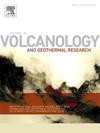The influence of graben geometry on dike propagation
IF 2.4
3区 地球科学
Q2 GEOSCIENCES, MULTIDISCIPLINARY
Journal of Volcanology and Geothermal Research
Pub Date : 2025-02-01
DOI:10.1016/j.jvolgeores.2024.108254
引用次数: 0
Abstract
Understanding dike behavior under varying topographical stresses is essential for predicting volcanic vent locations. This study addresses how graben geometry influences dike propagation by employing an experimental approach to simulate dike propagation, using fluids as analogs for magmas. We inject these fluids into the center of the base of an elastic gelatin medium, molded with an elongated topographic low representing a graben structure in the Earth's crust. Experiments involving different graben geometries were conducted to assess how local stress fields influence dike propagation. The results demonstrate that shallow grabens facilitate vertical to sub-vertical dike propagation within the graben, while deeper grabens cause dike deflection, often leading to off-graben venting or the formation of canoe-like sheet intrusions. These findings introduce new variables into the understanding of volcanic vent locations and eruption forecasts, particularly in rift zones with complex topography. The results offer critical implications for improving volcanic hazard assessments by incorporating the influence of topographical stress on dike propagation. Overall, the study advances our understanding of the mechanisms controlling dike propagation and provides a basis for further research into mitigating risks associated with volcanic eruptions in a graben setting.
地堑几何形状对堤坝扩展的影响
了解不同地形应力下岩脉的行为对于预测火山口位置至关重要。本研究通过采用实验方法模拟岩脉传播,利用流体作为岩浆的类似物,解决了地堑几何形状如何影响岩脉传播。我们将这些液体注入一种弹性明胶介质的底部中心,这种介质是用一种细长的地形图塑造的,代表着地壳中的地堑结构。实验涉及不同的地堑几何形状,以评估如何局部应力场影响岩脉的传播。结果表明,浅地堑有利于地堑内垂直至亚垂直的岩脉扩展,而深地堑则导致岩脉偏转,往往导致地堑外喷流或形成独木舟状片状侵入体。这些发现为了解火山口位置和喷发预测,特别是在地形复杂的裂谷带,引入了新的变量。这些结果为通过纳入地形应力对岩脉扩展的影响来改进火山危险性评估提供了重要的意义。总的来说,该研究促进了我们对控制岩脉扩展机制的理解,并为进一步研究减少地堑环境中火山爆发相关风险提供了基础。
本文章由计算机程序翻译,如有差异,请以英文原文为准。
求助全文
约1分钟内获得全文
求助全文
来源期刊
CiteScore
5.90
自引率
13.80%
发文量
183
审稿时长
19.7 weeks
期刊介绍:
An international research journal with focus on volcanic and geothermal processes and their impact on the environment and society.
Submission of papers covering the following aspects of volcanology and geothermal research are encouraged:
(1) Geological aspects of volcanic systems: volcano stratigraphy, structure and tectonic influence; eruptive history; evolution of volcanic landforms; eruption style and progress; dispersal patterns of lava and ash; analysis of real-time eruption observations.
(2) Geochemical and petrological aspects of volcanic rocks: magma genesis and evolution; crystallization; volatile compositions, solubility, and degassing; volcanic petrography and textural analysis.
(3) Hydrology, geochemistry and measurement of volcanic and hydrothermal fluids: volcanic gas emissions; fumaroles and springs; crater lakes; hydrothermal mineralization.
(4) Geophysical aspects of volcanic systems: physical properties of volcanic rocks and magmas; heat flow studies; volcano seismology, geodesy and remote sensing.
(5) Computational modeling and experimental simulation of magmatic and hydrothermal processes: eruption dynamics; magma transport and storage; plume dynamics and ash dispersal; lava flow dynamics; hydrothermal fluid flow; thermodynamics of aqueous fluids and melts.
(6) Volcano hazard and risk research: hazard zonation methodology, development of forecasting tools; assessment techniques for vulnerability and impact.

 求助内容:
求助内容: 应助结果提醒方式:
应助结果提醒方式:


